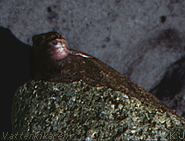
This periwinkle has been enclosed in a dried leaf from the red alga
of the species Porphyra. Both the periwinkle and the alga endure
being out of the water for prolonged periods of time very well. The
periwinkle avoids dehydration by simply closing its shell. The alga
cannot stop the loss of water, but survives anyway, in spite of losing
most of its water.
Immediately after the water level has decreased and
Marine organisms are left stranded in the air, they begin to lose
water. To be able to survive in the beach zone, creatures must have
organs and tissues that can endure water loss, or have mechanisms
that prevent or minimize the loss of water. These mechanisms can be
protective body parts, a certain type of behaviour, or both. |
Those organisms, for example, rock
lice, that have the ability to move, are able to avoid dehydration
in a very good way. They simply move to an area that is moist. Such
areas would naturally be underwater, but even crevices and cavities
amongst the cliffs and rocks or under rocks and algae, in fact anywhere
with a low rate of evaporation. Protection against dehydration and
certain predators, e.g. birds, means that nearly all organisms, even
the attached, are common in these micro-environments, but whilst competing
for space, not all organisms will be able to find a refuge. Furthermore,
it can be too dark for a great many algae.
Many beach living organisms have a physique and special
organs that help to protect them against dehydration. The common mussel
and barnacle
for example, protect themselves by enclosing themselves in their thick
shells. Many shellfish have a lid with which they close the aperture
of their shell. |


